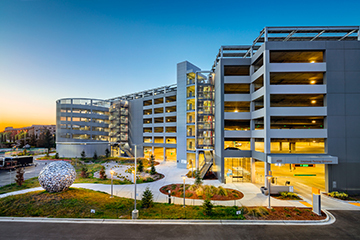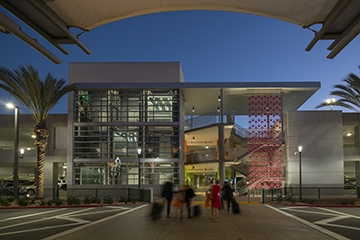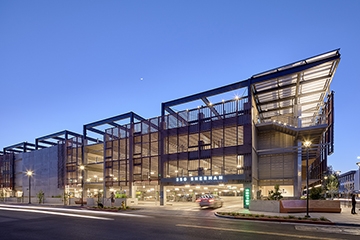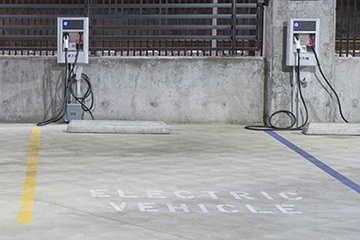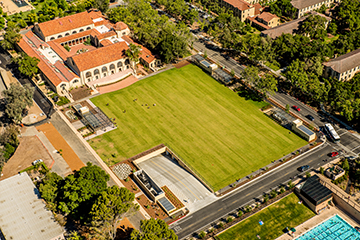Sustainable design is a vital component to the future of our built environment. As we continue to look for more ways to make projects energy efficient and environmentally friendly, parking provides a number of opportunities to contribute to those goals.
In addition to supporting a larger project’s LEED or LEED equivalent goals through energy savings or stormwater management infrastructure, sustainable best practices such as EV charging and green roofs can assist in achieving Parksmart certification for standalone structures. Every parking project provides unique opportunities for green solutions. Here are just a few ways parking contributes to sustainable design.
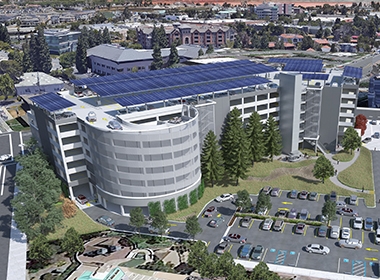 The San Mateo County Government Center Parking Structure will feature a 1,350 panel PV system.
The San Mateo County Government Center Parking Structure will feature a 1,350 panel PV system.
Energy Efficient Design
Studies performed by the US Department of Energy show that residential and commercial buildings consume nearly 40% of the country’s energy. Given only 12% of energy consumption is renewable as of 2017, designing future facilities that consume only as much energy as they can produce on site can have a significant impact on climate change and creating a more sustainable future. This includes parking facilities.
With the exception of EV charging infrastructure, which can drive up energy usage considerably, parking structures have relatively low energy needs. Most are designed to take advantage of natural ventilation, and energy-saving lighting systems are becoming more and more standard best practices. In locations that experience high potential for solar power, such as California and Colorado, a photovoltaic array on the structure’s roof can pave the way towards a net zero parking facility.
In pursuit of net zero energy and LEED Gold certification for the County Office Building 3 complex, the County of San Mateo elected to integrate a 1,350 panel PV system covering the full roof of the parking structure that supports the new building. When the structure opens later this year, annual production of the array is expected to be around 900,000 kilowat hours.
Taking advantage of the high potential for solar power in Colorado, the Denver Health Acoma Parking Garage has actually achieved net positive energy. Approximately 300 days of the year, the structure’s PV array generates enough power to not only run the parking structure, but also create a surplus that is fed back into the grid. A 400 square foot storage room accommodates the high volume of lithium batteries required for energy storage.
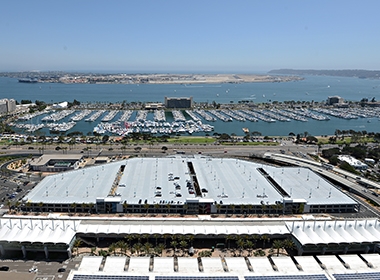 The innovative stormwater management system incorporated into the San Diego International Airport Terminal 2 Parking Plaza captures nearly 2 million gallons of rainwater a year.
The innovative stormwater management system incorporated into the San Diego International Airport Terminal 2 Parking Plaza captures nearly 2 million gallons of rainwater a year.
Managing Stormwater
Long thought of simply as waste, stormwater runoff management is being considered more and more as an important element of sustainable infrastructure by filtering pollutants, reducing flood risks and preventing erosion. In parking facilities, this can take the form of vegetated bio-retention swales and planters. However, it can also play a much larger role.
As part of an airport-wide initiative on sustainable stormwater management, the San Diego International Airport Terminal 2 Parking Plaza features an innovative 100,000 gallon underground holding system. Storage pipes 36-inches in diameter beneath the bottom level of the structure capture, treat and reuse nearly two million gallons of rainwater annually to feed the central utility plant (CUP), which uses nearly 30,000 gallons of potable water each day to manage the temperature in the airport terminals. As the airport would otherwise need to use city water to heat and cool the CUP, capturing and reusing stormwater preserves that resource for other uses.
This stormwater collection process played a key role in the Parking Plaza being awarded Parksmart Gold from the US Green Building Council and Envision Gold from the Institute of Sustainable Infrastructure.
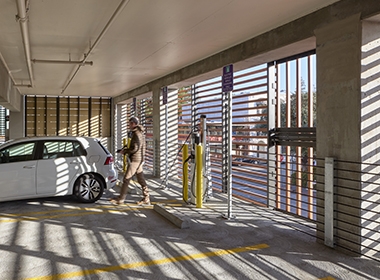 Palo Alto installed dual EV charging stations in a new parking structure to more efficiently manage power demand.
Palo Alto installed dual EV charging stations in a new parking structure to more efficiently manage power demand.
Preparing for an Electrical Future
According to the Office of Energy Efficiency and Renewable Energy, of the nine billion barrels of petroleum used in the US last year, two-thirds were spent on transportation. Electric vehicles produce fewer emissions and smog, and overall have a smaller carbon footprint with fewer lifecycle emissions than their gasoline-powered equivalents. In order to encourage greater adoption of this more sustainable method of transportation, sufficient charging stations must be available. While this increases the electrical load on a parking facility, it paves the way for a more global sustainable benefit.
Armed with this knowledge, when Palo Alto needed more public parking to support a new Public Safety building planned for downtown, they saw an opportunity to invest in the electrical future. Design of the new parking structure included 32 EV charging spaces that were available to users on opening day, with 125 additional spaces wired for future installations.
Such ambitious EV requirements pose unique design challenges to accommodate the increase in both electrical capacity and load. The transformer at the California Avenue Garage had to be upsized to accommodate chargers for 125 future EV spaces. In order to lessen the overall power demand, 95% of the EV spaces in the facility will utilize power sharing dual chargers. When two cars are plugged into a dual charger, each receives 50% power, instead of twice the power, which will decrease the electrical requirements by almost half compared to providing single chargers.
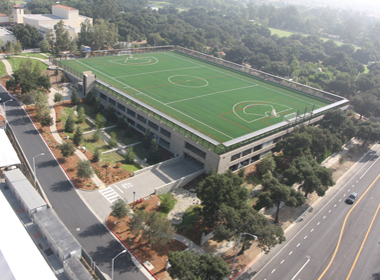 The Pomona College Parking Structure features a green roof of synthetic turf that reduces irrigation by 50,000 gallons of water per week.
The Pomona College Parking Structure features a green roof of synthetic turf that reduces irrigation by 50,000 gallons of water per week.
Preserving Green Space
Parking structures can offer an opportunity to provide a valuable sustainable element in the form of a green roof. Green roofs can reduce the heat island effect, provide a means to manage stormwater and even improve air quality. Beyond the sustainable elements, green roofs also have the benefit of enhancing the user experience by providing an amenity and preserving valuable public space.
Stanford University has taken this approach with a number of underground parking structures. The green roofs over the Roble Field and Manzanita parking facilities allow the University to meet growing parking needs while preserving recreational space for students. Roble Field provides open grass space for students to gather, relax and enjoy recreational sports, while Manzanita also offers athletic courts for basketball and volleyball. A parking structure at the Medical Center preserves Governor’s Lane, a historic pedestrian path that runs across the site.
Pomona College installed a green roof over their parking facility that is sized to NCAA standards for women’s and men’s lacrosse and soccer. Bio-swales take the storm water collected from the playing field and filter it back into the ground. The use of synthetic turf instead of natural grass reduces irrigation by 50,000 gallons of water per week and reduces discharge into the environment by eliminating fertilizers.
Parksmart Certification
Innovative ways to integrate sustainable design that promote greener parking are at the heart of Parksmart, a rating system designed to advance sustainable parking structure design and operation. While the built environment measures the implementation of sustainable best practices using LEED certification, standalone parking structures are not eligible for LEED. Instead they are evaluated using the USGBC’s Parksmart rating. The system breaks best practices into three categories: Management, Programs, Technology and Structure Design. Points are awarded and scored at Bronze, Silver and Gold levels.
Achieving Parksmart certification becomes a collaboration between the owner, design professional and contractor. Of the 248 points available in the Parksmart program, over 50 percent are driven by the designer, more than 30 percent are under the primary control of the owner and approximately 10 percent are controlled by the contractor. Numerous points require collaboration to provide the documentation, so careful planning and early understanding of the points necessary for certification is critical to success.
These are only a few of the ways that parking contributes to a more sustainable future. Whatever your green project goals may be, parking best practices are there to help you reach them.



